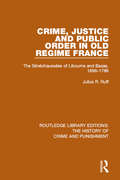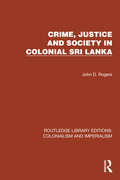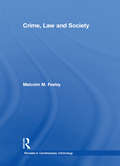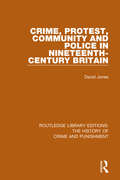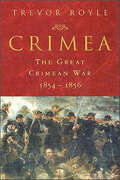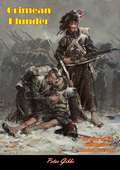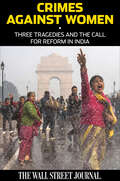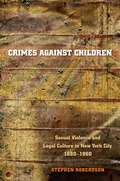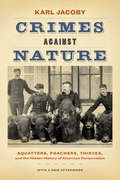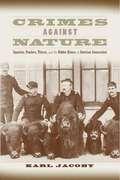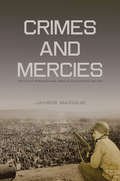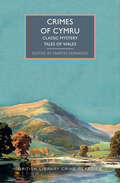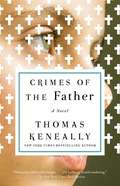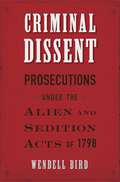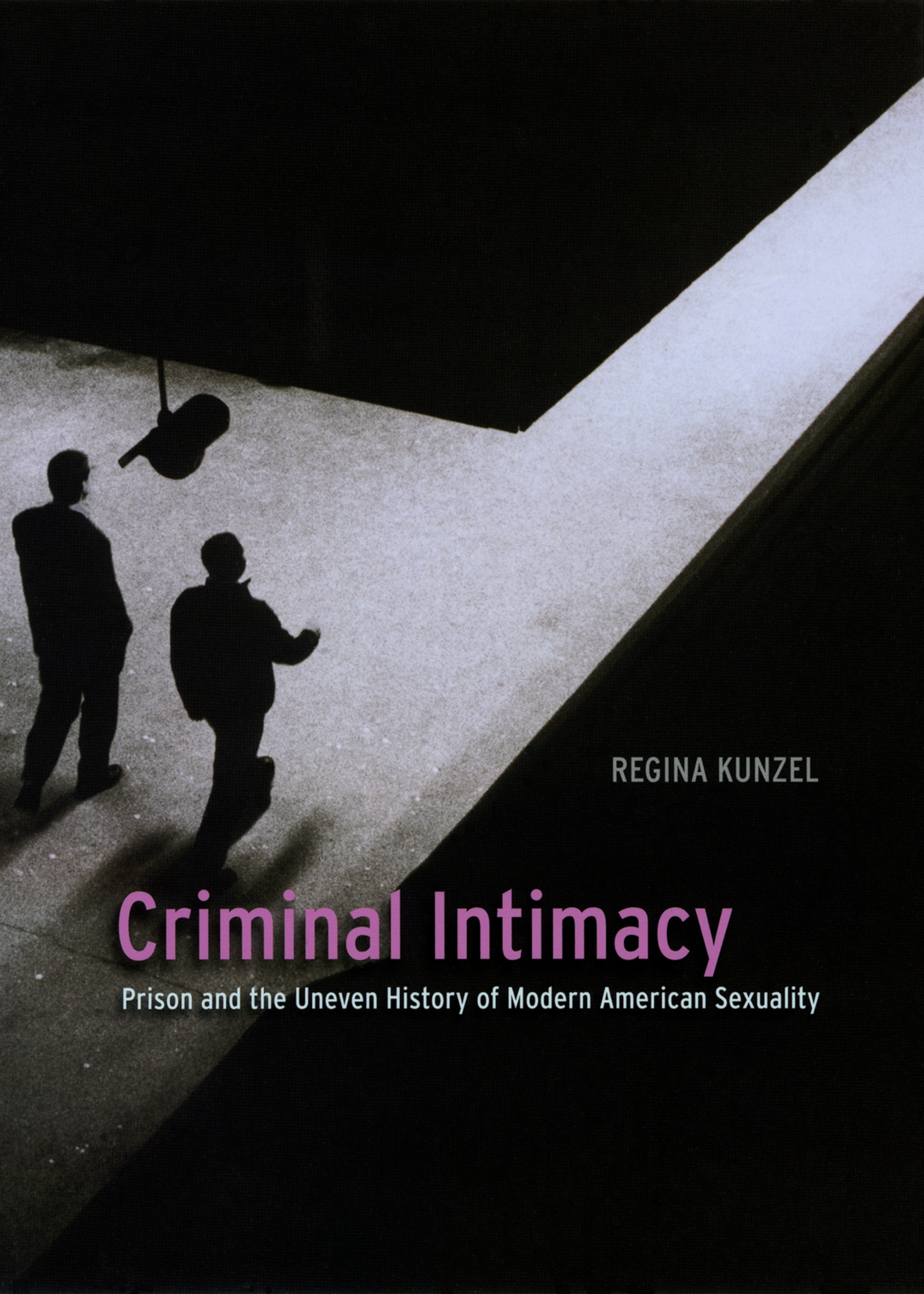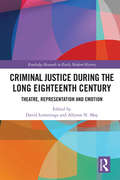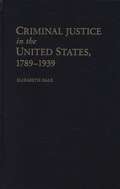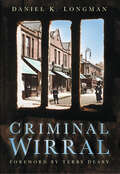- Table View
- List View
Crime, Justice and Public Order in Old Regime France: The Sénéchaussées of Libourne and Bazas, 1696-1789 (Routledge Library Editions: The History of Crime and Punishment #8)
by Julius R. RuffThis title, first published in 1984, is a case study of crime and criminal justice in rural, southwestern France in the last century of the Old Regime. Based on extensive research in criminal court records, often the only documentary evidence of the poor and illiterate, the study is a valuable addition both to our knowledge of Old Regime society and to our understanding of its judicial institutions. Rural, Old Regime France seethed with violence. Assault, homicide, and a violence of speech occurred frequently at all levels of society. The author’s finding that royal fiscal and judicial officials were recurring targets of this violence additionally contributes to our understanding of the revolutionary events ending the Old Regime. This system, providing in principle for judicial torture and corporal and capital punishments for relatively minor crimes, has long epitomized much that was wrong with pre-revolutionary France. But the law in principle is not the law in practice, and the author finds that both local and appeals courts seldom decreed such measures. This book will be of interest to students of history and criminology.
Crime, Justice and Society in Colonial Sri Lanka (Routledge Library Editions: Colonialism and Imperialism #21)
by John D. RogersCrime, Justice and Society in Colonial Sri Lanka (1987) examines Sri Lanka’s justice system under British rule, and concentrates on two of its aspects: the effectiveness of the administration of law and order, and the relationship between crime and social change. It argues that the colonial judicial system did penetrate rural areas, but did not operate in the way the British intended. Instead, Sri Lankans adapted the state institutions so that they functioned more effectively within indigenous culture.
Crime, Law and Society: Selected Essays (Pioneers In Contemporary Criminology Ser.)
by MalcolmM. FeeleyMalcolm Feeley‘s work is well-known to scholars around the world and has influenced two generations of criminologists and legal scholars. He has written extensively on crime and the legal process and has published numerous articles in law, history, social science and philosophy journals; two of his books, The Process is the Punishment and Court Reform on Trials, have won awards. This volume brings together many of his better-known articles and essays, as well as some of his lesser-known but nevertheless important contributions, all of which share the common theme of the value of the rule of law, albeit a more sophisticated concept than is commonly embraced. The selections also reveal the full range of his interests and the way in which his research interests have developed.
Crime, Protest, Community, and Police in Nineteenth-Century Britain (Routledge Library Editions: The History of Crime and Punishment #5)
by David JonesThis study, first published in 1982, is concerned with the nature of crime in nineteenth-century Britain, and explores the response of the community and the police authorities. Each chapter is linked by common themes and questions, and the topics described in detail range from popular forms of rural crime and protest, through crime in industrial and urban communities, to a study of the vagrant. The author pays special attention to the relationship between illegal activities and protest, and emphasizes the context and complexity of official crime rates and of many forms of criminal behaviour. This title will be of interest to students of history and criminology.
Crime-Terror Nexus in South Asia: States, Security and Non-State Actors (Asian Security Studies)
by Ryan ClarkeThis book examines the crime-terror nexus in South Asia, focusing in particular on the activities of non-state actors that operate out of Pakistan, and challenges the conventional wisdom that the Pakistan Taleban (TTP) and Al-Qaeda are Pakistan’s most serious security threats. Much research has focused on the policies of India and Pakistan towards Kashmir. But surprisingly little attention has been paid to several notable Pakistan-based non-state actors who are increasingly operating on their own, and who have the potential to greatly inhibit, if not derail, the peace process there. These groups blur the line between terrorism and organized crime with serious implications for policy in the region. India and Pakistan can engage in confidence-building measures, but if criminal actors such as Lashkar-i-Taiba (LeT) and D-Company cannot effectively be controlled, a lack of trust between both sides will remain. Although the role of regular military forces is not to be discounted, many of the non-state actors in Indian-Held Kashmir, such as LeT, are not confined by the same restraints as state forces, thus allowing them engage in more violent actions without fear of reprisal. In order for lawmakers, security personnel, and others to develop sound, comprehensive policies, these forces and their potential to undermine political initiatives must be fully appreciated. This book explores the dynamics of the relationship between Pakistan, D-Company, and LeT and how it affects strategic thought, decision-making, and security interests in the region and explains the triangular relationships between states, terrorist groups, and organized criminal syndicates in general, and in India and Pakistan in particular. This book will of much interest to students of South Asian politics, terrorism, organised crime, war and conflict studies, and Security Studies in general.
Crimea: The Great Crimean War, 1854–1856
by Trevor RoyleThe definitive history of the Crimean War from world-renowned historian Trevor Royle.The Crimean War is one of history's most compelling subjects. It encompassed human suffering, woeful leadership and maladministration on a grand scale. It created a heroic myth out of the disastrous Charge of the Light Brigade and, in Florence Nightingale, it produced one of history's great heroes. New weapons were introduced; trench combat became a fact of daily warfare outside Sebastopol; medical innovation saved countless soldiers' lives that would otherwise have been lost. The war paved the way for the greater conflagration which broke out in 1914 and greatly prefigured the current situation in Eastern Europe.
Crimean Blunder: The Story of War with Russia a Hundred Years Ago
by Peter GibbsFirst published in 1960, this book details the events in Turkey, the Crimea and the shores of the Black Sea during the military conflict fought from October 1853 to March 1856, in which Russia lost to an alliance of France, the British Empire, the Ottoman Empire, and Sardinia.In writing his book, English-born Zimbabwean author and BSA Police Reserve Superintendent, Peter Gibbs, attempts to tell a plain story, rather than to present a scholarly history text, and this is reflected in his easy-to-read yet highly informative style of writing.An excellent account, richly illustrated throughout with detailed maps and photographs taken during the Crimean war."[I]f the Crimean War deserves no label of greatness it cannot be dismissed as altogether negligible as wars go, if only because it cost nearly three hundred thousand lives."--Peter Gibbs
Crimean War: 1854-1856 (Essential Histories #2)
by John SweetmanFirst Published in 2001. Routledge is an imprint of Taylor & Francis, an informa company.
Crimes & Criminals of 17th Century Britain
by Daniel J. CoddThink the world is bad today? Then take a true-crime trip back in time to 1600s England, where violence, robbery, and cold-blooded murder ran amuck. These days, criminals and evildoers are stopped, caught, and punished every day. But how did people deal with crimes before the police, computer records, and a consistent judicial system even existed? Here are the stories of some of the most heinous, shocking, and unbelievable transgressions of the law in seventeenth century England, raising questions such as . . . Which murderer committed an atrocity at an East End brothel in 1691?What superstitions lay behind the unfathomable slaughter of three innocent children at a remote farmhouse in County Durham in 1683?When was a parish constable murdered in cold blood by a party of men that allegedly included the illegitimate son of King Charles II?Where did deadly confrontations occur between supporters and opponents of King James II during the so-called Bloodless Revolution of 1688? These cases, and many more, are explored in depth, harkening back to a time of witch hunts, dueling, and political assassinations, when the punishment for killing one&’s fellow man was either more barbaric than the crime itself, or corruptly lenient. Illustrated throughout and shedding a unique light on the era, Crimes & Criminals of 17th Century Britain is the first work of its kind to explore the monstrous murders that occurred at a time when the nation was repeatedly plunged into chaos.
Crimes Against Humanity: A Beginner's Guide (Beginner's Guides)
by Adam JonesMurder, extermination, enslavement, ethnic cleansing, rape, and torture: when carried out in a widespread or systematic way, these constitute 'crimes against humanity'. And the international community still has a long way to go to eradicate them. In examples ranging from the genocide in Darfur and Rwanda, to the sex trade of Eastern Europe, to the use of torture on detainees, Jones recounts touching real-life stories from victims and survivors of crimes against humanity worldwide. This guide outlines the history and current extent of key crimes against humanity, investigates the current stumbling blocks which prevent full compliance with international law, and highlights many of the success stories. Adam Jones is Associate Professor at the University of British Columbia, Canada. He is executive director of Gendercide Watch and is Head of 'Genocide' the lead international journal on the subject. Please visit his website at http://www.crimesagainsthumanity.ca/.
Crimes Against Women: Three Tragedies and the Call for Reform in India
by The TheAs 2012 came to a close, news of the gang rape of a young woman in India’s capital generated headlines around the world. Her assault on a moving bus with a metal rod, and her death two weeks later from her injuries, focused attention on the dark side of the world’s largest democracy: the struggle that faces many Indian women in a country where chauvinistic and misogynistic attitudes prevail.The Wall Street Journal’s India bureau explored this horrendous crime and others that explore the experience of Indian women in the 21st century. The reporting in all the stories stands out for its gripping detail and its emotional pull. In many cases, central figures involved in these everyday dramas were speaking for the first time.The book begins with the story of a Catholic nun murdered in rural India as she tried to preserve ancient tribal ways in the face of mining expansion, while also coming to the aid of a woman who had allegedly been raped.Next is a riveting account of a young woman from rural Bihar who was duped into moving to Delhi, where she was forced to marry or go into prostitution -- and the disaster for her and her family that ensued. The woman broke her long-held silence to speak to the WSJ about what happened.The book ends with the WSJ’s world-beating coverage of the New Delhi rape case, including intimate portraits of the victim and her friend who tried to save her but couldn’t. He granted the WSJ intimate and exclusive access to tell his side of the story.In this e-book, we are bringing together these stories -- in many cases updated with fresh details of the individuals’ lives -- to show the hopes and the catastrophes, the bravery and the abuse that are the daily lot of millions of India’s women.
Crimes against Children
by Stephen RobertsonIn the first half of the twentieth century, Americans' intense concern with sex crimes against children led to a wave of public discussion, legislative action, and criminal prosecution. Stephen Robertson provides the first large-scale, long-term study of how American criminal courts dealt with the prosecution of sexual violence against children.Robertson describes how the nineteenth-century approach to childhood as a single phase of innocence began to shift at the end of the century to include several stages of childhood development, prompting reformers to create legal categories such as statutory rape and carnal abuse to protect children. However, while ordinary New Yorkers' involvement in the prosecution of those offenses reshaped their understandings of who was a child and produced a new concern to establish the age of their sexual partners, their beliefs in childhood innocence and in a concept of sexuality centered on sexual intercourse remained unchanged. As a result, families' use of the law and jurors' decisions ultimately diminished the protection the new laws offered to children. Robertson's study, based on the previously unexamined files of the New York County district attorney's office, reveals the importance of child sexuality and sex crimes in twentieth-century American culture.
Crimes against History
by Antoon De BaetsCrimes against History takes a global approach to the extreme forms of censorship to which history and historians have been subjected through the ages. The book opens by considering the varieties of censorship, from suppression, dismissal, and defamation to persecution and murder. Part I, "Kill switch," tells the tragic story of how the censorship of history has sometimes turned into deadly crimes against history, with chapters looking at topics such as historians and archivists being killed for political reasons, attacks by political leaders on historians, iconoclastic breaks with the past, and fake news. Part II, "Fragile freedom," reverses the perspective and examines how the censorship of history has backfired. Chapters consider the subversive power of historical analogies and resistance to the censorship of history. The book also contains a "Provisional memorial for history producers killed for political reasons (from ancient times until 2017)". It is a double tribute: to the history producers who were killed and to those who mustered the courage to resist the blows of censorship. Comparing case studies from across the world and written from a human rights perspective, Crimes against History is an essential resource for anyone interested in how deeply history and politics influence each other, as well as for anyone wanting a fuller view of the history of history.
Crimes against Nature
by Karl JacobyCrimes against Nature reveals the hidden history behind three of the nation's first parklands: the Adirondacks, Yellowstone, and the Grand Canyon. Focusing on conservation's impact on local inhabitants, Karl Jacoby traces the effect of criminalizing such traditional practices as hunting, fishing, foraging, and timber cutting in the newly created parks. Jacoby reassesses the nature of these "crimes" and provides a rich portrait of rural people and their relationship with the natural world in the late nineteenth and early twentieth centuries.
Crimes against Nature: Squatters, Poachers, Thieves and the Hidden History of American Conservation
by Karl JacobyCrimes against Nature reveals the hidden history behind three of the nation's first parklands: the Adirondacks, Yellowstone, and the Grand Canyon. Focusing on conservation's impact on local inhabitants, Karl Jacoby traces the effect of criminalizing such traditional practices as hunting, fishing, foraging, and timber cutting in the newly created parks. Jacoby reassesses the nature of these "crimes" and provides a rich portrait of rural people and their relationship with the natural world in the late nineteenth and early twentieth centuries.
Crimes and Cover-ups in American Politics: 1776-1963
by Donald JeffriesThe history that the textbooks left out. For far too long, American history has been left in the unreliable hands of those that author Donald Jeffries refers to as the court historians. Crimes and Cover-ups in American Politics: 1776-1963 fights back by scrutinizing the accepted history of everything from the American War of Independence to the establishment reputation of Thomas Jefferson and the other Founding Fathers, the Civil War, the Lincoln assassination, both World Wars, US government experimentation on prisoners, mental patients, innocent children and whole populated areas, the Lindbergh baby kidnapping and much, much more. Secular saints like Abraham Lincoln, Theodore Roosevelt, and Franklin D. Roosevelt are examined in a critical way they seldom have been. Jeffries spares no one and nothing in this explosive new book. The atrocities of Union troops during the Civil War, and Allied troops during World War II, are documented in great detail. The Nuremberg Trials are presented as the antithesis of justice. In the follow-up to his previous, bestselling book Hidden History: An Expose of Modern Crimes, Conspiracies, and Cover-Ups in American Politics, Jeffries demonstrates that crimes, corruption, and conspiracies didn't start with the assassination of President John F. Kennedy. History should be much more than cardboard villains and impossibly unrealistic heroes. Thanks to the efforts of the court historians, most Americans are historically illiterate. Crimes and Cover-ups in American Politics: 1776-1963 is a bold attempt at setting the record straight.
Crimes and Mercies
by James BacqueMore than 9 million Germans died as a result of deliberate Allied starvation and expulsion policies after World War II-one quarter of the country was annexed, and about 15 million people expelled in the largest act of ethnic cleansing the world has ever known. Over 2 million of these alone, including countless children, died on the road or in concentration camps in Poland and elsewhere. That these deaths occurred at all is still being denied by Western governments.At the same time, Herbert Hoover and Canadian Prime Minister MacKenzie King created the largest charity in history, a food-aid program that saved an estimated 800 million lives during three years of global struggle against post-World War II famine-a program they had to struggle for years to make accessible to the German people, who had been excluded from it as a matter of official Allied policy.Never before had such revenge been known. Never before had such compassion been shown. The first English-speaking writer to gain access to the newly opened KGB archives in Moscow and to recently declassified information from the renowned Hoover Institution in California, James Bacque tells the extraordinary story of what happened to these people and why.Revised and updated for this new edition, bestseller Crimes and Mercies was first published by Little, Brown in the U.K. in 1997.
Crimes of Cymru: Classic Mystery Tales Of Wales (British Library Crime Classics)
by Martin Edwards"Ahoy, my lad!" he bellowed back."I didn't expect you so early. Come for a dip! The water's fine. Everything is—"Then it happened.Mystery and murder run amok amidst ominous peaks and icy lakes. In hushed valleys, venom flows through villages harboring grievances that span generations. The landscapes and locales of Wales ("Cymru," in the Welsh language) have fired the imagination of some of the greatest writers in the field of crime and mystery fiction.Presenting fourteen short stories first published in 1909 through the 1980s, this new anthology celebrates a selection of beloved Welsh authors Cardiff's Roald Dahl and Abergavenny's Ethel Lina White, as well as lesser-known yet highly skilled writers including Cledwyn Hughes and Jack Griffith. Alongside these home-grown tales, this collection also includes a handful of gems inspired by, or set in, the cities and wilds of Wales by treasured authors with an affinity for the country, such as Christianna Brand, Ianthe Jerrold, and Michael Gilbert.
Crimes of the Father: A Novel
by Thomas KeneallyFrom one of our greatest living writers, a bold and timely novel about sin cloaked in sacrament, shame that enforces silence, and the courage of one priest who dares to speak truth to power.Sent away from his native Australia to Canada due to his radical preaching against the Vietnam War, apartheid, and other hot button issues, Father Frank Docherty made for himself a satisfying career as a psychologist and monk. When he returns to Australia to lecture on the future of celibacy and the Catholic Church, he is unwittingly pulled into the lives of two people—a young man, via his suicide note, and an ex-nun—both of whom claim to have been sexually abused by a prominent monsignor. As a member of the commission investigating sex abuse within the Church, and as a man of character and conscience, Docherty decides he must confront each party involved and try to bring the matter to the attention of both the Church and the secular authorities. What follows will shake him to the core and call into question many of his own choices. This riveting, profoundly thoughtful novel is “the work of a richly experienced and compassionate writer [with] an understanding of a deeply wounded culture” (Sydney Morning Herald). It is an exploration of what it is to be a person of faith in the modern world, and of the courage it takes to face the truth about an institution you love.
Criminal Dissent: Prosecutions under the Alien and Sedition Acts of 1798
by Wendell BirdThe prosecution of dissent under the Alien and Sedition Acts affected far more people than previously realized. It also provoked the first battle over the Bill of Rights. Wendell Bird provides the definitive account of a dark moment in U.S. history, reminding us that expressive freedom and opposition politics are essential to a stable democracy.
Criminal Intimacy: Prison and the Uneven History of Modern American Sexuality (University Of Chicago Geography Research Papers)
by Regina KunzelSex is usually assumed to be a closely guarded secret of prison life. But it has long been the subject of intense scrutiny by both prison administrators and reformers—as well as a source of fascination and anxiety for the American public. Historically, sex behind bars has evoked radically different responses from professionals and the public alike. In Criminal Intimacy, Regina Kunzel tracks these varying interpretations and reveals their foundational influence on modern thinking about sexuality and identity. Historians have held the fusion of sexual desire and identity to be the defining marker of sexual modernity, but sex behind bars, often involving otherwise heterosexual prisoners, calls those assumptions into question. By exploring the sexual lives of prisoners and the sexual culture of prisons over the past two centuries—along with the impact of a range of issues, including race, class, and gender; sexual violence; prisoners’ rights activism; and the HIV epidemic—Kunzel discovers a world whose surprising plurality and mutability reveals the fissures and fault lines beneath modern sexuality itself. Drawing on a wide range of sources, including physicians, psychiatrists, sociologists, correctional administrators, journalists, and prisoners themselves—as well as depictions of prison life in popular culture—Kunzel argues for the importance of the prison to the history of sexuality and for the centrality of ideas about sex and sexuality to the modern prison. In the process, she deepens and complicates our understanding of sexuality in America.
Criminal Justice During the Long Eighteenth Century: Theatre, Representation and Emotion
by David Lemmings Allyson N. MayThis book applies three overlapping bodies of work to generate fresh approaches to the study of criminal justice in England and Ireland between 1660 and 1850. First, crime and justice are interpreted as elements of the "public sphere" of opinion about government. Second, "performativity" and speech act theory are considered in the context of the Anglo-Irish criminal trial, which was transformed over the course of this period from an unmediated exchange between victim and accused to a fully lawyerized performance. Thirdly, the authors apply recent scholarship on the history of emotions, particularly relating to the constitution of "emotional communities" and changes in "emotional regimes".
Criminal Justice in the United States, 1789–1939
by Elizabeth DaleThis book chronicles the development of criminal law in America, from the beginning of the constitutional era (1789) through the rise of the New Deal order (1939). Elizabeth Dale discusses the changes in criminal law during that period, tracing shifts in policing, law, the courts and punishment. She also analyzes the role that popular justice - lynch mobs, vigilance committees, law-and-order societies and community shunning - played in the development of America's criminal justice system. This book explores the relation between changes in America's criminal justice system and its constitutional order.
Criminal Wirral
by Terry Deary Daniel K Longman'Criminal Wirral' is an intriguing and entertaining collection of some of the strangest, most despicable and comical crimes that took place on the Wirral peninsula from the Victorian era up until the early twentieth century. Daniel K. Longman's painstaking research has uncovered many fascinating cases that have been long forgotten, and he sheds new light on local causes celebres. The tales are supported by a number of maps with many contemporary and modern photographs, which help to bring these events and the people featured in them to life. Criminal Wirral will appeal to anyone who has an interest in the darker side of Wirral's history.
Criminal Women: Famous London Cases
by John J. EddlestonShocking portraits of women who have committed capital crimes in England’s capital city—from the author of Jack the Ripper: An Encyclopedia. Women have sometimes been seen as less criminally inclined than men. But, as John J. Eddleston shows in this revealing anthology of female crimes in London, this image is hard to mesh with reality, for the city’s history is crowded with cases of women who broke the law. In vivid detail, he reconstructs a series of dramatic, often harrowing, cases in which women were involved and puts their acts in the context of their times. Taking episodes from the eighteenth century to near the present day, he looks at criminal women of all types, from all walks of life. The work of the London police, the courts, and the prisons is an essential element in his study, and each chapter reveals much about how attitudes toward crime and punishment have changed over the centuries. Fascinating portraits of these criminal women as individuals emerge from their stories; their cases come to life—as does the London in which they lived. They include Catherine Hayes, who was burnt alive for murdering her husband; three women hanged on the same day for highway robbery; two women executed for rioting; Anne Hurle and Charlotte Newman, who were both hanged for forgery; Florence Bravo, who was sensationally acquitted of murder; and, perhaps most famous of all, Ruth Ellis, whose execution in 1955 provoked an outcry against capital punishment.
